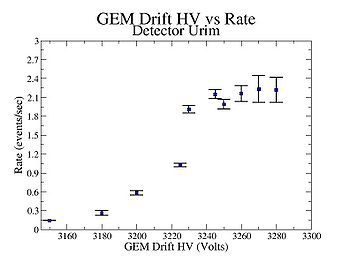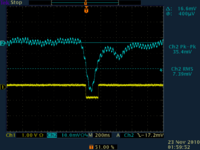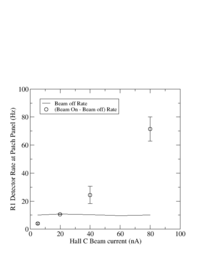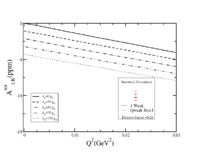ForestNSFInterimReport 8-31-11
000416256
2p0
Participants
Tony Forest Principal Investigator Yes Phil Cole Principal Investigator No Dan Dale Principal Investigator No Tamar Didberidze Graduate student Yes Danny Martinez Graduate student No Charles Taylor Graduate student No
Activities and Findings
This section will serve as your report to your program officer of your project's activities and findings. Please describe what you have done and what you have learned, broken down into four categories:
What have been your major research and education activities (experiments, observations, simulations,presentations, etc.)
The nuclear physics group at Idaho State University has been actively engaged in three experiments at Jefferson Lab; Qweak, Primex, and g13. PI Forest and graduate students T. Diberidze and W. Parsons have worked on installing the R1 tracking detector and readout electronics for Qweak. PI Dale, has worked to published the latest results from the Primex experiment and is currently preparing to take data in Jefferson Lab's Hall B. PI Cole and graduate students D. Martinez, J. Salamanca and C. Taylor have been working with CLAS' g8 and g13 run groups in JLab's Hall B. Two students, W. parsons and J. Salamanca, have graduated this year. The progress of these endeavors is described below.
Qweak Region 1 Tracking System Detector
The testing and installation of the Region 1 tracking system for the Qweak experiment at Jefferson Lab has been a research activity supported by this grant. The Qweak Region 1 tracking system is one of three tracking systems designed to measure the profile of elastically scattered electrons as well as background contributions to the parity violating signal. The Region 1 tracking system is located behind the first collimator at a distance of about 550 cm from the main torus magnet ( 200 cm from the target). The collimator divides the acceptance into 8 regions, octants, and reduces the azimuthal acceptance by almost 30 percent.
Two Region 1 detectors were built at ISU and delivered to JLab after observing signals which indicated that the detectors were sensitive to ionizing radiation. Figure 1a in the last annual report illustrated a detector mounted in position for a commissioning test. Although ionixation signals were observed in the JLab test facility prior to installation, signals were not observed from the detector during the commissioning run. It was found that the detector was damaged by a spark discharge at some point during the commissioning tests. The detector was removed from the experimental Hall and repaired by graduate student T. Didberidze in the JLab test facility using GEM foils from the second R1 detector.
The R1 detector was put through several additional tests before installing it back into the Hall. Figure 1a shows the measured cosmic rate as a function of high voltage. The detector appeared to plateau at the expected cosmic rate of about 2 Hz. Additionally,a Co-60 radiation source was used to demonstrate to the collaboration that the detector's counting rate increased when the source was placed in the detector's acceptance. The success of these tests was used to justify placing the detector in the experimental Hall. The detector was placed far from the target and not inside the R1 enclosure in order to make it easier to repair if there was another failure. On November 22, 2010 a beam test was conducted in Hall C. As shown in figure 1c, the detector rate was observed to depend on the beam current. The R1 detector appeared to be working.
On January 10, 2011, the R1 detector was moved to a region just outside the acceptance of the main detector. A test stand was built that placed two large scintillators upstream and downstream of the R1 detector. During a low current tracking run the detector was moved to a location that would intercept elastically scattered electrons. A low efficiency of 4% was measured by collaborators. It is believed that the detector was under voltage during these measurements. The plan was to increase the voltage during the next tracking run.
Unfortunately, collaborator Kathleen Johnston decided to remove the detector from the Hall before the next test. As documented in Louisiana Tech's NSF reports, Louisiana Tech is "responsible for the R1 tracking system". The ISU group was responsible for delivering a detector to Louisiana
Tech which...
Louisiana Tech was also responsible for the detector readout electronics and rotation system for R1 even though ISU was working on a candidate system. It has been reported that the detector no longer reaches the operating high voltage used previously in the Hall.
Primex
Significant progress has been made in the program to measure the neutral pion lifetime. First, the results of the first run (PrimEx I) were accepted for publication in Physical Review Letters (Phys.Rev.Lett. 106 (2011) 162303) where a radiative width of 7.83 +- 0.14 (stat) +- 0.17 (sys) eV was reported. This number is a factor of 2.5 times more precise than the current Particle Data Group average and is consistent with theoretical predictions.
Second, the data taking run for PrimEx II was performed in the Fall of 2010. Dan Dale is a spokesperson for this experiment and served as a run coordinator. The primary goal of the run was to increase the statistical precision of the measurement. Improvements on the setup over thay of PrimEx I included (1) modifications to the photon beam line to minimize the effect of collimator scraping, (2) individual TDC’s were implemented in the central portion of the HYCAL pion detector, and (3), data on both a carbon and a silicon target were obtained to further investigate the model dependence of the analysis.
Third, major progress was made in the area of documentation of the techniques utilized in PrimEx I to limit the uncertainty in the luminosity to about 1%. A draft of a paper has been written by Dan Dale based on the work of his student, Aram Teymurazyan, and has been circulated to a small group of PrimEx members. Based on feedback on this, a draft will be prepared and circulated to the Collaboration for ultimate submission to Nuclear Instruments and Methods.
g8b and g13a/b (polarized photons off protons and deuterons)
(For greater details, please see the final report to Award ID: 0555497 PI: P.L. Cole)
The g8b dataset will measure the beam asymmetry (and other polarization observables) using polarized photons interacting with protons and deuterons which result in the final states ηp, KY (Y=Λ,Σ0, Σ+), ρ0p, (ρ+n), ωp, and φp from Eγ=1.1 GeV to 2.1 GeV. This is to be compared to measured asymmetries at GRAAL (Eγ < 1.5GeV) to higher energy which observed the final states ηp, K+Λ . For φp g8b will afford an extension of the measured asymmetry at SPring8 (Eγ >1.7 GeV) to lower energy and higher t. Julian Salamanca has completed his Ph.D. thesis titled: THE PHOTOPRODUCTION OF φ-MESONS OFF PROTONS BY USING A BEAM OF LINEARLY POLARIZED PHOTONS AT THRESHOLD ENERGIES on October, 2009 (see http://www.jlab.org/~salamanc/phd_thesis_new-5-ds-v3.pdf). Danny Martinez is currently working on his thesis titled: THE PHOTOPRODUCTION OF ω-MESONS OFF PROTONS BY USING A BEAM OF LINEARLY POLARIZED PHOTONS AT THRESHOLD ENERGIES.
Similarly, the g13a/b datasets will yield the measurement of beam asymmetry (and other polarizeation observables) in ηp, ηn, KY (Y=Λ,Σ0, Σ+,Σ-), ρ0p, ρ0n,(ρ+n & ρ-p), ωp, and φp from Eγ=1.1 GeV to 2.3 GeV. Charles Taylor is currently working on his thesis title: THE PHOTOPRODUCTION OF THE KΛ OFF NEUTRONS BY USING A BEAM OF LINEARLY AND CIRCULARLY POLARIZED PHOTONS.
Physics Analysis
Graduate students T. Didberidze, D. Martinez, and C. Taylor are analyzing Jefferson Lab data sets taken in Hall B. T. Didberidze is currently analyzing data from Hall B's EG1 run group which will test independent fragmentation for SIDIS. D. Martinez is has completed calibrating the time-of-flight system for the g13 experiment and is now searching for omega mesons in g8 data set for his thesis. C. Taylor used his calibration work on g13 to calibrate the start counter for the FROST experiment at Jlab as a collaborative service task.
What are your major findings from the activities identified above
The figure below shows the statistical precision which can be achieved for a measurement of the low energy constant known as d_{Delta} using the current Qweak data set from Run I. The figure shows the expected inelastic PV asymmetry for several values of d_{Delta} as a function of Q^2. The low energy constant d_{Delta} characterizes the parity violating electric dipole matrix element for the transition accessible by inelastic parity violation measurements on the proton. The application of Siegert's theorem at the photon point, (Q^2=0), results in the Q^2 independence of the transition amplitudes leading term. The statistical precision of a 1 week long measurement, predicted using the current data set, is shown in the figure as well. In addition to measuring a fundamental low energy constant, the results may also have implications to hyperon decay physics as d_{Delta} impacts the asymmetry parameter in radiative hyperon decay physics such as the decay.
What research and teaching skills and experience has the project helped provide to those who worked on the project
Describe the opportunities for training and development provided by your project.
As part of their graduate studies, students working with the group gain skills and experiences in the area of detector development and error analysis. Students working with PI Forest have been trained in the use of electronics for nuclear physics. One student wrote the library for a readout system and designed electronics boards. Another student instrumented detectors for performance tests including building their own NIM module. Students working with PI Cole have been calibrating the CLAS detector and using those results together with their analysis programs to analyze photo nuclear reactions.
What outreach activities have you undertaken to increase public understanding of, and participation in, science and technology?
Describe outreach activities your project has undertaken.
The physics department also holds a mentoring program for high school teachers and their students during the first month of summer. The group previously instructed about 14 teachers and students on the operating principles of drift chambers and scintillators. The students were part of an REU program at Idaho State University and were tasked with designing and constructing PMT bases for use in experiments at the Idaho Accelerator Center. The program is a fortuitous example of how research and education can combine efforts and improve the public's understanding of science and technology. Unfortunately the program did not take place this year because of time conflicts between the program and the PIs schedules. We anticipate continuing the program next year.
Publications and Products
In this section, you will be asked to describe the tangible products coming out of your project. Specifically:
What have you published as a result of this work? Journal publications
Books or other non-periodical, one-time publications
What Web site or other Internet site have you created?
What other specific products (databases, physical collections, educational aids, software, instruments, or the like) have you developed?
What have you published as a result of this work?
This work is in progress and has not resulted in any publications.
Journal publications
- Deeply Virtual Compton Scattering Beam-Spin Asymmetries., F.X. Girod et al. (The CLAS Collaboration), Phys. Rev. Lett. 100, 162002 (2008). http://link.aps.org/abstract/PRL/v100/e162002
- Beam spin asymmetry in deep and exclusive p0 electroproduction., R. De Masi et al. (The CLAS Collaboration), Phys. Rev. C 77, 042201 (2008). http://link.aps.org/abstract/PRC/v77/e042201
- Cross Sections for gamma p to K0*+ Sigma at Egamma=1.7-3.0 GeV , I. Hleiqawi, et. al., Phys. Rev. C 75,2007, 042201.
- Separated Structure Functions for the Exclusive electroproduction of K+ Lambda and K+ Sigma Final States , P. Ambrozewicz, et. al., Phys. Rev. C 75,2007, 045203.
- First measurement of Beam Recoil Observables C(x) and C(z) in hyperon Photoproduction , R. Bradford, et. al., Phys. Rev. C 75,2007, 035205.
Quark-Hadron Duality in Spin Structure Functions g1p and g1d , P. Bosted, et. al., Phys. Rev. C 75,2007, 035203.
Books or other non-periodical, one-time publications
Insert Phil's proceedings from the south america conference.
Already inserted. Here is the link:
http://scitation.aip.org/proceedings/confproceed/1265.jsp
What Web site or other Internet site have you created?
Wiki
What other specific products (databases, physical collections, educational aids, software, instruments, or the like) have you developed?
Contributions
Now we invite you to explain ways in which your work, your findings, and specific products of your project are significant. Describe the unique contributions, major accomplishments, innovations and successes of your project relative to :
the principal discipline(s) of the project;
other disciplines of science or engineering;
the development of human resources;
the physical, institutional, or information resources that form the infrastructure for research and education; and
other aspects of public welfare beyond science and engineering, such as commercial technology, the economy, cost-efficient environmental protection, or solutions to social problems.
How have your findings, techniques you developed or extended, or other products from your project contributed to the principal disciplinary field(s) of the project?
Special Requirements
From Dan:
The group's activities in regards to the {\em PrimEx} experiment at
Jefferson Laboratory have focussed on writing publications resulting from
the last run as well as preparing for the upcoming run at Jefferson Laboratory which is
scheduled to run from September 27, 2010 to November 10, 2010.
The {\em PrimEx} Collaboration is in the final stages of editing a paper to be submitted to Physical Review Letters in the next couple of weeks. In this paper, we report a radiative neutral pion decay width, $\Gamma(\pi^o\rightarrow \gamma \gamma)$ of $7.82 \pm 0.14 (stat) \pm (0.17) (syst) eV$. This result is considerably more precise than the current Particle Data Book average (2.5 times more precise), and is consistent with current chiral perturbation calculations including next-to-leading order. In addition to this paper, substantial progress has been made on a paper describing high precision photon flux measurements for tagged photon experiments. Publication of this paper is expected during year two of this grant.
For the upcoming {\em PrimEx} run, the ISU group has taken primary responsibility for the pair spectrometer online luminosity monitor. During this period, considerable work was performed on the pair spectrometer including electronics checkout, upgrading and calibrating the scintillator detectors, and development of the run plan as it impacts the luminosity monitoring. As spokesperson for the experiment, Dr. Dale has also written the relevant safety documentation for the experiment which is required by the Laboratory, and has been involved in the preparation for the run at all levels.
ARRA reports
000416256
7/14/10
ARRA funding has supported the activities of 5 personnel working to fulfill the research objectives outlined in NSF award #PHY-0855661. The objectives of the last quarter, as described in the above proposal, were to complete installation of the Qweak detectors in Hall C at Jefferson Lab and begin the construction of the R1 chambers for Hall B. The Qweak detectors for Jlab's Hall C have been delivered and one of the detectors is currently operating in the Hall. The mounting system for the detectors was the responsibility of another institution and has faced some challenges delaying it's completion. T. Didberidze and principal investigator, T. Forest, have made two trips to JLab to complete the installation and plan at least one final trip at the end of July. The construction of the R1 drift chambers for Hall B has been delayed by Hall B management for about 8 months. B. Starks has been designing several clean room options to facilitate the construction of the R1 chambers during the past quarter and will finalize the design by the end of July. C. Taylor used his calibration work on g13 to calibrate the start counter for the FROST experiment at Jlab as a collaborative service task. D. Martinez is has completed calibrating the time-of-flight system for the g13 experiment and is now using that calibration to search for mesons to analyze for his thesis. W. Parsons defended his thesis on the Qweak readout system and is currently completing thesis revisions. J. Salamanca has graduated since the last quarter and taken a position at another institution.
1/14/10
ARRA funding has supported the activities of 6 personnel working to fulfill the research objectives outlined in NSF award #PHY-0855661. The objectives of the last quarter, as described in the proposal, were to complete testing of the Qweak region 1 tracking system and begin installing a clean room. T. Didberidze has completed testing the Qweak region 1 detector and has shipped one of the two detectors to JLab. B. Starks has received two air shower enclosures for the clean room and has installed a temperature monitoring system. W. Parsons has completed a software library which will be used in a readout system for the Qweak detector. J. Salamanca has graduated with a Ph. D. in physics and will be starting an academic position in Colombia. D. Martinez is calibrating a time-of-flight system for the g13 experiment in JLab's hall B. C. Taylor is calibrating the Large Angle Calorimeter for the g13 experiment in JLab's Hall B.



